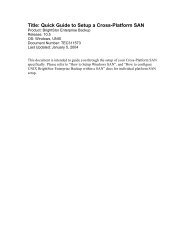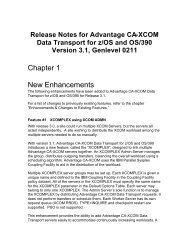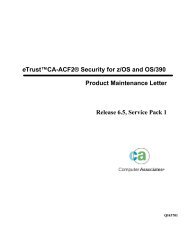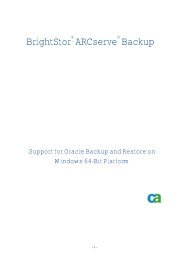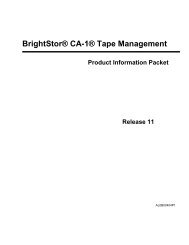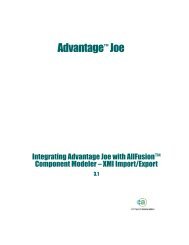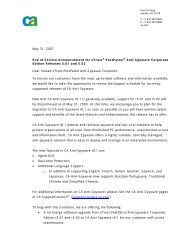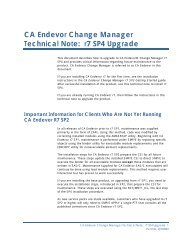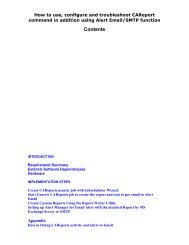eTrust CA-Top Secret Security for z/OS and OS ... - SupportConnect
eTrust CA-Top Secret Security for z/OS and OS ... - SupportConnect
eTrust CA-Top Secret Security for z/OS and OS ... - SupportConnect
- No tags were found...
Create successful ePaper yourself
Turn your PDF publications into a flip-book with our unique Google optimized e-Paper software.
<strong>eTrust</strong> <strong>CA</strong>-<strong>Top</strong> <strong>Secret</strong> <strong>and</strong> the SYSPLEX XES FunctionHow does this all work? You must first define the list structure to the CouplingFacility. Then <strong>for</strong> each system enter a TSS MODIFY (SYSPLEX) comm<strong>and</strong> todefine the connect-name, structure-names, <strong>and</strong> group-name, <strong>and</strong> toautomatically connect each system to the Coupling Facility.The <strong>Security</strong> File ENQ record, the first physical record in the <strong>Security</strong> File, isused to keep control in<strong>for</strong>mation about the <strong>Security</strong> file, including file lockingstatus. The ENQ record includes the Coupling Facility structure name, <strong>and</strong> theCoupling Facility validity record includes the volume serial number (VOLSER)of the <strong>Security</strong> File. This in<strong>for</strong>mation is stored by the first system that connects tothe Coupling Facility structure, <strong>and</strong> is used by systems that connect subsequentlyto ensure that a unique <strong>Security</strong> File data set <strong>and</strong> structure name combination isused among all connected systems. When a local system attempts to lock the<strong>Security</strong> File, the structure name in the <strong>Security</strong> File ENQ record is compared tothe local system's currently defined structure.Whenever the <strong>Security</strong> File is locked by a non-Coupling Facility connectedsystem, the structure name found within the ENQ record is validated to beactive, <strong>and</strong> the local system connects to the same structure, be<strong>for</strong>e proceedingwith any update activity against the file.While the current system is active in the Coupling Facility, if the <strong>Security</strong> FileENQ record is altered by another system <strong>and</strong> it no longer contains the structurename, all systems are <strong>for</strong>ced to disconnect from the Coupling Facility.When a Coupling Facility connected system manually disconnects from thestructure, all other connected systems are <strong>for</strong>ced to disconnect as well, to ensurethat no residual data is left in the Coupling Facility while one of the systems isrunning without an XES connection. An XES sysplex connection without an XCFconnection is allowed.After a system is <strong>for</strong>ced to disconnect from a structure, as a result of a manualdisconnect comm<strong>and</strong>, all other connected systems are <strong>for</strong>ced to disconnect. Nore-connect is attempted until a new structure is allocated in the Coupling Facilityby a manual connect comm<strong>and</strong>, or by a new system starting up. To determine ifa structure was reallocated, use the TSS MODIFY(STATUS(SYSPLEX))comm<strong>and</strong>, or the D XCF,STR <strong>OS</strong>/390 operator comm<strong>and</strong>. Compare the currentversion number to the version number of the previous connection.3–4 Cookbook



